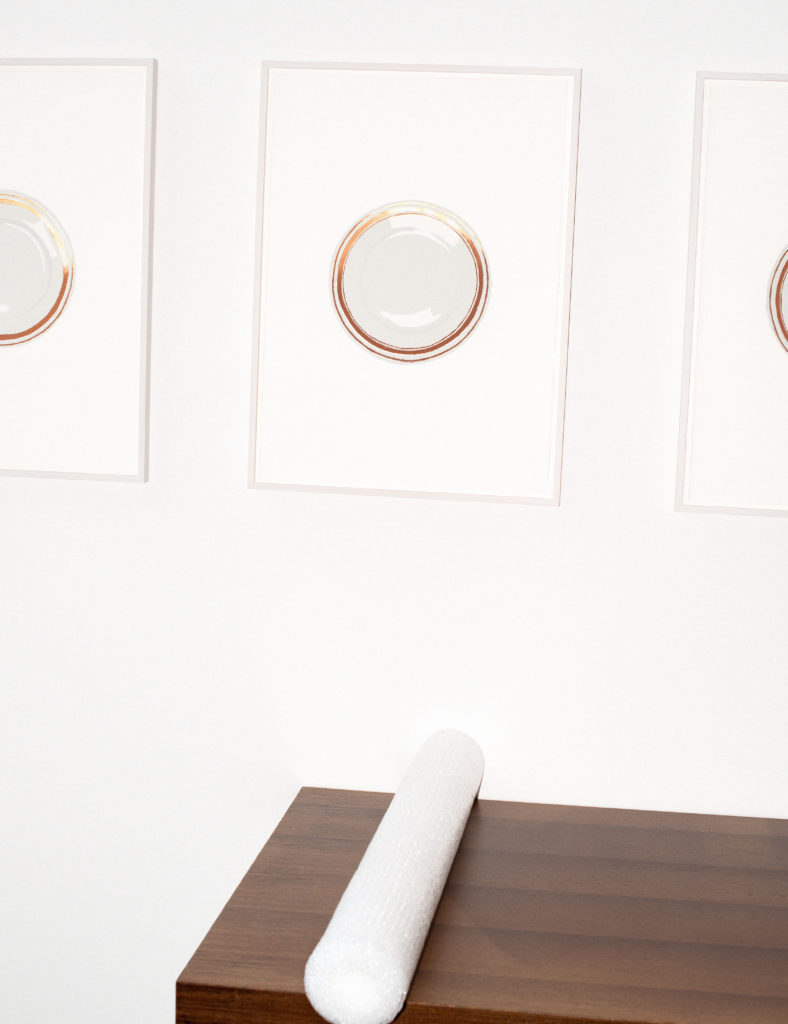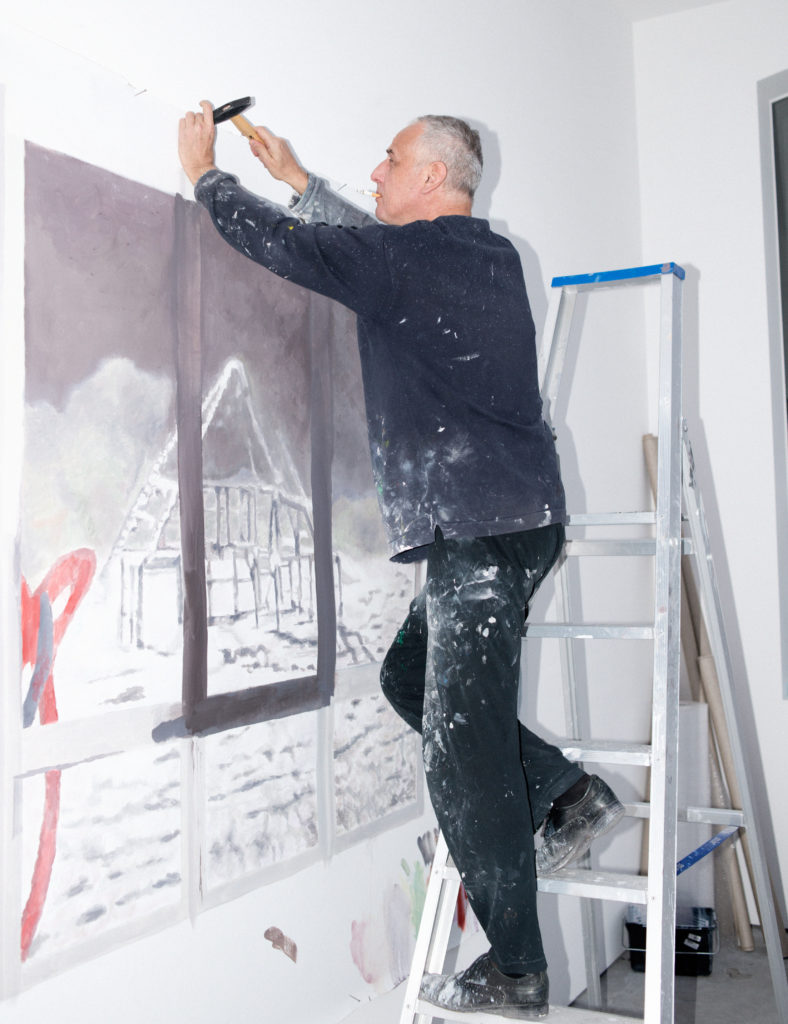Belgian artist Luc Tuymans is known for his creative fearlessness, and the filmmaker and painter’s work remains radical and in demand. With work currently on show at the 2017 Jakarta Biennale, Francesca Gavin speaks with the artist about the creative process, political commentary and the power of the image.
Once upon a time painting was dead. It is hard to believe in the current fervour for the medium that it was seen as passé mere decades ago. Then Luc Tuymans came along with work that helped to reinvent the position of painting. He made pigment hot. Tuymans, 59, is one of the most celebrated painters of his time
The Belgian artist, who lives in Antwerp, has exhibited at the Venice Biennale and Documenta; he has shown at the world’s most renowned museums including the Stedelijk Museum in Amsterdam, New York’s MoMA, Centre Pompidou in Paris and Tate Modern in London. His work regularly sells for seven-figure sums at auction. He’s one of the big guns of contemporary art today. He certainly looks the part, sitting in a modernist chair, chain-smoking in a private room at David Zwirner’s space in London, where I meet him.
His all-black outfit contrasts against the milky blue of his eyes, which exude a sense of sharp intelligence and perhaps even a touch of confrontation. Tuymans, who has written books on artists and curated exhibitions alongside his own work, knows his subject. Tuymans is a busy man. Tuymans’s paintings are not always straightforward.
In exhibitions they are presented as an amalgam of associations and analogies, history and contemporaneity. His work often draws upon found imagery and plays with ideas of translation and transformation. The results feel like comments on how images are formed, on the meaning of authenticity or how reality is remembered. Though he works with photographic images, film is a strong influence. “I come from a television generation,” Tuymans tells me. “There has been a long-standing fascination much more with the moving image or the filmed image than, let’s say, the photographic image. Ultimately it has to do with light and things that are ungraspable.”
There is a strong political strain to his work – his 2001 Belgium Pavilion at the Venice Biennale examined the country’s colonial history. Yet things are off key. Whether it is the Holocaust or Isis or the far right, Tuymans’s take on these subjects comes with results outside expectation. As he puts it, “I don’t believe that artists and art can be truly political.” Instead he sees the results as a form of commentary, a shadow, a translation of things through time. “If you look at all the shows I did about the Jesuits, or even the shows about the magic of Walt Disney theme parks, there has always been this interest in the theme of power. How power is constructed but also depicted,” he notes.
This is an artist highly aware of the effect of images. “I said very early on in my career that my entire work is based upon the idea of violence or the history of violence. But that can be different things – that can be from the gruesome element of mutilation, which is physical, to psychological violence. I’m very well aware of the impact of confrontational things… often confrontation actually has more of an impact than the idea of, let’s say, paradise, or the idea of happiness.” Violence is here but we are instead looking at the aftermath. It isn’t dark or bloody; the work is more insidious, subtler. “It’s a little bit like the Fritz Lang technique in M [1931], where you see a balloon and it is banging against the telegraph pole and you hear the crying and a little kid has died,” Tuymans explains, giving his approach a film context.
He works fast – most of his paintings are made in a day, though Tuymans emphasizes the “long, long, tedious period” of preparation, research, drawing and maquettes, “when all the imagery is assembled and analyzed” before the painting itself begins. The speed of the actual painting process has been something that has developed over time. “It has to do with my short attention span – but also it is important for the intentionality in the work. Not to lose yourself in painting details, you really have to force yourself to that moment, which is quite harrowing in a sense. It is quite nervous. It is a build-up towards that one day. It is not like I paint every day, that’s not a possibility.”
Tuymans always paints away from anyone else and there is a sense of intimacy in the work – sometimes reflected in a smaller scale, though the works have grown bigger as his studio has over time. “I don’t project the image, but I draw it with a pencil in wet paint and that’s how the form actually grows. I don’t paint on stretched canvases, just a nail on the wall so that every canvas I eventually put onto a stretcher is different in size.” His colour palette is quite recognizable with its swathes of greys and muted tones. “It is quite inherent to the region I come from, we have mostly grey skies. But there is a luminescence in that grey sky which is particular. And I’m a big believer in tonality in terms of creating depth as reality within painting.
This also means that it is very difficult for a viewer to actually retain as a memory, which makes it all the more powerful,” he considers. “That is why the paintings will have to sort of resonate within somebody’s head. That makes it interesting because that gives you the idea of a deconstructive image much more than a static image.” This isn’t, however, history painting with a capital H. “The idea of genre is still valid, but it’s totally inappropriate,” he says. “I think history painting in a clearly formulated way is something that goes much more back to the 19th century. Things can have a historical or political background at a moment in time but the idea of it being a genre is deluded and invalid. It can be anything, basically. Every image has a history of its own. I could do something very small but the consequences can be very big, or it could be the other way around.”
Some of Tuymans’s subjects are small, even domestic. One painting was of his father’s radiator. “Interiors are interesting because they are interiors. They also have an element of order. A very old painting that I made in 1986 called Hotel Room came out of the fascination that when you’re in a hotel room you can [trash] the hotel room. But whenever you leave, the order will be restored so that there is this animosity, this anonymous element to it.” There is something emotional in the works but where Tuymans himself sits within his work is hard to discern. “I’ve always made a big distinction between what I am and what the work is – they’re two different entities. There is also a sort of element of distancing yourself, which I think is important just in order to create the work,” the artist explains. “When I started out, the paintings were very existential. There was a sort of torturous element that finally led me to stop painting. I felt suffocated and so worked with film instead for a while.”
This two-year break in the early 1980s allowed him to, as he has put it, “come back through this lens”. He explains: “You need distance. What is important is the amount of space that is between the viewer and the actual two-dimensional work on the wall – that’s where the emotions lie.” Tuymans’s success has not been without glitches. A few years ago he was embroiled in a legal case over one of his paintings, which referenced a photograph of a Flemish nationalist politician. The photographer, Katrijn Van Giel, accused him of plagiarism and, controversially, the Belgian court ruled in her favour; the case was appealed and the two parties eventually settled out of court. However, that ruling, many argued, undermined the entire history of appropriation in art.
Tuymans, like Richard Prince and Barbara Kruger before him, is not the first artist to be taken to court for alleged misuse of images, the technique of appropriation having formed the basis of contemporary art since the late 1970s. Indeed, photographs have been used as references since their invention. The subject for Tuymans’s piece is the far-right politician, Jean-Marie Dedecker, which in itself raised eyebrows. “The politician had some airplay because of this,” he notes ironically. “There was a show that supported me with about 150 artists making works derived from the same image. He came to the opening and stayed for five hours. He found it fantastic, of course.”
It has been a busy few years, yet, despite riding the crest of a wave, Tuymans remains detached and in control yet he is a man whose passion for art and creation continues to thrive. “I like painting, my happiest moments are when I am in the studio painting,” he says quite dryly. Tuymans brightens when his phone rings – it’s his wife – and his time is up.
Photography by Alex Salinas
A version of this story appeared in the Autumn 2015 issue of Baku magazine.







